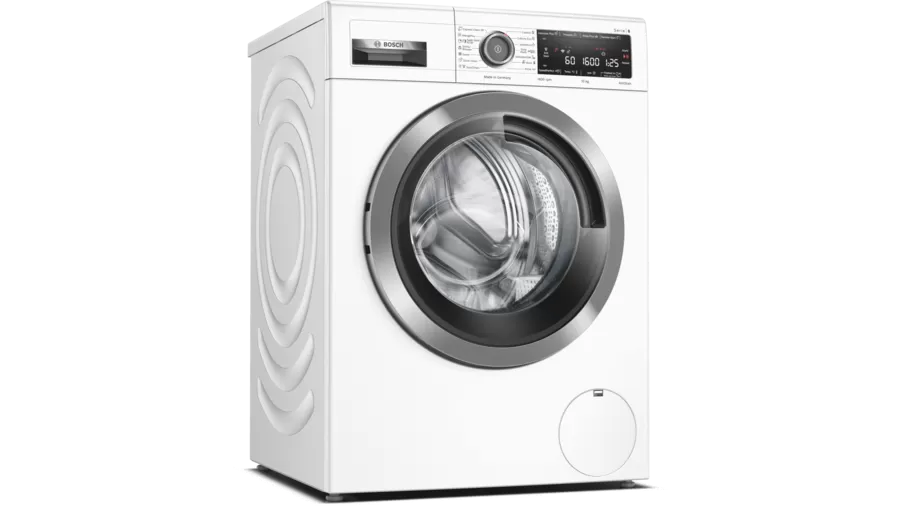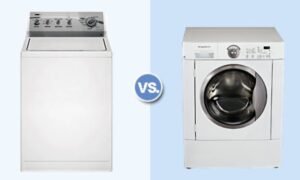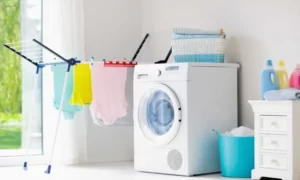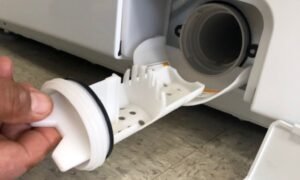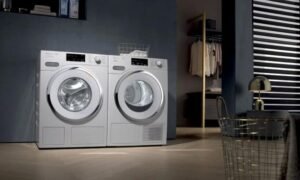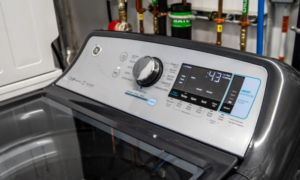Last updated on June 25th, 2023 at 05:58 am
The correct washing machine must be chosen if laundry is to be completed quickly and effectively. To choose wisely among the many types and models of washing machines on the market, it’s important to comprehend their characteristics and advantages. The front-loading washing machine is one common variety and has a number of benefits over other choices. We shall cover the main characteristics, advantages, and factors of front-loading washing machines in this post.
Benefits of Front Loading Washing Machines

Photo Source: Lg
Many advantages that front loading washing machines offer make them a popular option for consumers. Let’s examine these benefits in further detail:
Superior Cleaning Performance
Front loading machines are known for their exceptional cleaning capabilities. A complete and effective wash is achieved by totally immersing and efficiently agitating the garments in the horizontal drum design. This makes garments cleaner and improves stain and odor removal.
Gentle on materials
Front loaders’ tumbling movement makes them gentle on materials. Top loading washing machines don’t have agitators, which lowers the possibility of tangled or damaged clothing during the wash cycle. Front loaders may now be used for delicate clothing, extending the life of your items in the process.
Water Efficiency
Front-loading washing machines utilize water more effectively than top-loading ones. With these machines, the same load of clothes may be washed with less water. The horizontal drum design makes it possible to adequately soak garments while minimizing water use. This saves water while also lowering your water expenses.
Energy Efficiency
Front loaders are generally more energy-efficient than top-loading machines. They consume less power as a result of innovations like load detection, shorter wash cycles, and lessened water heating needs. Your power costs will go down and the environmental effect will be minimized thanks to the lower energy use.
Greater Capacity
Front-loading washers frequently have a bigger capacity, enabling you to wash more garments in a single load. For families with more substantial washing requirements or heavy furnishings like beds and drapes, this is especially advantageous. Larger loads require fewer cycles, which saves you time and energy.
Space Saving Design
Front-loading machines are often designed to be stackable, with the option to place a dryer on top. When you don’t have much floor space in your laundry room, this function comes in very handy. You may maximize vertical space and make a more compact, well-organized configuration by stacking the machines.
Key Features to Consider of Front Loading Washing Machines

Photo Source: cubeonline
There are some important aspects to think about when selecting a front-loading washing machine that can improve your laundry experience. Let’s delve deeper into these attributes:
Drum Size and Capacity
The amount of laundry you can wash in a single load and the actual dimensions of the machine depend on the drum capacity and size of the washing machine, which are important considerations. Here are two crucial factors to think about:
Load Capacity
The load capabilities of front loaders differ widely and are often expressed in kilos or pounds. To choose the right load capacity, take into account the size of your home and the amount of laundry you regularly need to wash. By lowering the number of loads necessary, choosing a higher load capacity can help you save time and energy.
Space-Saving Design
The design of front-loading machines frequently includes space-saving elements like stackability. This enables you to effectively utilize vertical space by stacking a dryer on top of the washer. A stackable front loader is a great option if you have little floor space in your laundry room and want to make the most of it.
Advanced Washing Technology
Modern technology is frequently included in front-loading washing machines to improve their functionality and convenience. Think about the following attributes:
Multiple Wash Cycles
Seek out washers with a selection of wash cycles designed to suit various fabric kinds and laundry requirements. Normal, delicate, heavy-duty, fast wash and eco-friendly choices are among the frequently used wash cycles. With a variety of cycles, you may adjust the wash procedure to suit certain items or soiling levels.
Customizable Settings
It can be useful to have control over variables like wash time, spin speed, and water temperature. Look for front-loading washers that let you change these settings to suit your tastes and unique washing needs. Flexible settings provide for the best cleaning outcomes while ensuring flexibility.
Smart Connectivity
Some contemporary front-loading washers have connection capabilities and smart functions. These appliances may be linked to your home’s Wi-Fi network, allowing you to use a smartphone app to remotely monitor and manage the washing process. Smart connection makes life easier and lets you monitor the status of your clothes.
You may choose a front-loading washing machine that best meets the demands of your home and improves your laundry routine by taking into account the drum capacity and size as well as the cutting-edge washing technology features.
Comparison with Top-Loading Washing Machines

Photo Source: quora
The distinctions between front-loading and top-loading washing machines must be taken into account while selecting a washing machine. To assist you in making an educated choice, the following table compares front-loading washing machines with their top-loading counterparts:
Cleaning Performance:
Front-loading machines are renowned for their outstanding cleaning abilities. Because of the horizontal drum’s design, garments may be cleaned thoroughly and with better agitation.
– Top Loading: Top loading washers with agitators may not clean as well as front loaders. The agitator might not clean as well and might occasionally lead to tangling.
Fabric Care:
– Front Loading: Due to its tumbling movement, front loaders are kind to textiles. This is particularly advantageous for delicate clothing that needs a soft wash cycle.
– Top Loading: Top loaders with agitators could be harsher on textiles and may result in damage or tangling, especially for delicate goods.
Energy and water efficiency:
– Front Loading: Front loaders often use less water and are more eco-friendly. Due to their design, they consume less water and utilize less energy to operate, which results in lower utility costs.
– Top Loading: Top loaders often consume more water and energy, particularly those equipped with conventional agitators, which need more water for efficient washing.
Load Capacity:
– Front Loading: You can wash more clothing in a single load thanks to front loaders’ frequently higher load capabilities. For homes that need more laundry, this may be useful.
– Top Loading: Because top loaders often have smaller load capacity, washing the same quantity of clothes may require more frequent loads.
Ergonomics and Accessibility
– Front Loading: People with mobility concerns can find front loaders less convenient because they have to bend down to load and unload the laundry. They frequently feature a flat top, though, which may be folded or stored.
– Top Loading: Top loaders enable you to load and unload clothes from the top without leaning down, making them more accessible. Additionally, they make it convenient to add lost objects while the wash cycle is running.
Price Range:
– Front Loading: Due to its frequent inclusion of cutting-edge features and technology, front loaders often cost more than top loaders.
– Top Loading: Top loaders are often less expensive, making them a cost-effective solution for individuals who have financial constraints.
When choosing between a front-loading and a top-loading washing machine, take into account these variables. Front-loaders excel in cleaning tasks, caring for fabrics, conserving water and energy, and carrying heavier loads. Top loaders, on the other hand, provide accessible ease, the ability to add goods mid-cycle, and a more reasonable price range. Pick the one that best fits your priorities and washing needs.
Maintenance and Care Tips
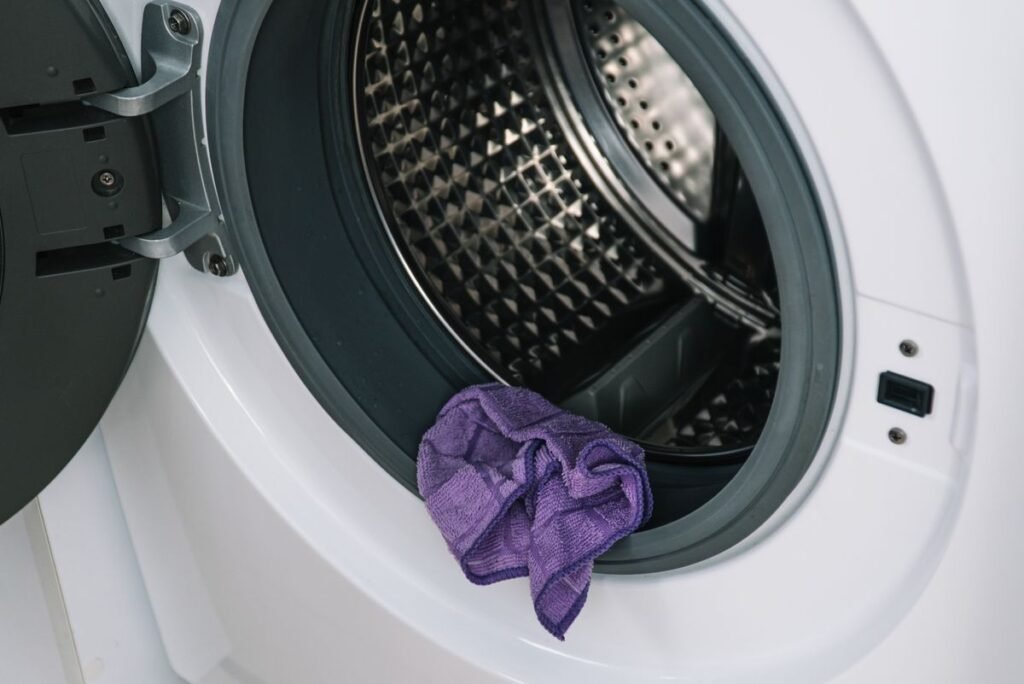
Photo Source: bestproducts
To preserve the durability and effective operation of your front-loading washing machine, proper maintenance and care are crucial. Here are some pointers for maintaining your machine in top shape:
Regular Cleaning:
– Clean the door seal: Use a moist cloth to wipe the door seal often to get rid of any dirt or debris. This aids in stopping the development of mold or mildew.
– Clean the detergent dispenser: To stop detergent residue from accumulating, remove and clean the detergent dispenser drawer. Prior to use it, give it a good rinse and allow it to air dry.
Cleaning a drum:
– Perform a routine cleaning cycle: Run an empty wash cycle using hot water and a cleaning chemical made especially for washing machines on a regular basis. This aids in removing any accumulation of dirt, odor-producing bacteria, and detergent residue.
– Keep the door slightly ajar after each wash to promote airflow and avoid the development of mold or mildew within the drum.
Maintenance of Filters and Hoses:
– Inspect and clean the filter: The front of front loaders has a filter that is close to the bottom. To get rid of any lint, dirt, or foreign objects that may have accumulated, check and clean this filter on a regular basis. To learn how to reach and clean the filter on your machine, consult the handbook.
– Check hoses and connections for leaks, damage, or other issues on a regular basis. Make sure the connections are solid and tight.
Proper Detergent Usage:
Use the right quantity of detergent by adhering to the manufacturer’s recommendations for the amount dependent on the load size and water hardness. The performance of the machine might be hampered by residue accumulation caused by using too much detergent.
Balanced Loads:
– Prevent overloading the device: Don’t fill the drum any more than is advised. A machine that is overloaded will work harder and clean less effectively.
– Balance the load: To reduce excessive vibration during the wash cycle, distribute the clothing equally in the drum. The machine may shake excessively due to unbalanced loads, which might potentially harm internal parts.
Professional Servicing:
– Arrange routine maintenance checks: Take into account hiring a qualified service specialist to examine and maintain your washing machine on a regular basis. Any possible concerns may be found and handled by them before they develop into significant ones.
You can make sure that your front-loading washing machine runs effectively, produces the best cleaning results, and lasts a long time according to these maintenance and care guidelines.
Common Solutions and Troubleshooting

Photo Source: kellysdrycleaners
Throughout their useful lives, top-loading washing machines may have a few problems. Here are some typical troubleshooting guidelines and fixes for these issues:
Machine Doesn’t Start:
– Inspect the power supply: Make sure the device is hooked into a functioning power outlet. Check to see whether the fuse or circuit breaker hasn’t blown or tripped.
– Door/Lid switch: Check to see whether your machine’s door or lid switch is working properly. The machine could not turn on if the switch is broken.
Machine Fails to Spin:
– Unbalanced or overloaded load: This might prevent the machine from spinning. To achieve a balanced load, redistribute the clothing in the drum in an equitable fashion.
– Lid switch: The machine may not spin if the lid switch is broken or not correctly engaged. Make sure the lid switch is functioning properly by checking it.
Excessive Vibration or Noisy Operation:
– Verify load distribution: An uneven distribution of clothing in the drum might result in excessive machine vibration. To obtain a balanced distribution, rearrange the load.
– Leveling: Make sure the machine is appropriately leveled. To steady the machine, inspect and adjust its feet using a spirit level.
Water Leakage:
– Inspect the connections and hoses: Check the hoses for leaks or other damage. If the connections are loose, tighten them. Any damaged connections or hoses must be replaced.
– Drain pump or tub seal: If the water leaking continues, there may be a problem with the drain pump or tub seal. It is best to seek expert assistance for repair or replacement in such circumstances.
The machine Doesn’t Agitate
– Lid switch: Make sure the lid switch is operating properly by checking it. A broken lid switch might stop the machine from stirring.
Drive belt: Check to verify if the drive belt is in good condition and is positioned correctly. The belt may need to be changed if it is worn out, frayed, or damaged.
Suds or excessive foam:
Use the proper detergent, making sure to use the right kind and quantity for your top-loading machine. A lot of detergent can produce a lot of froth.
– Perform more rinse cycles: Perform additional rinse cycles to get rid of extra detergent if you see a lot of froth or suds during a wash cycle.
It is advised to reference the manufacturer’s handbook or get in touch with a certified service professional for more help and repair if these troubleshooting suggestions do not fix the problems with your top-loading washing machine.
Conclusion
Top-loading washing machines offer a unique combination of benefits and factors to take into account. We have examined the main characteristics and typical solutions for top-loading machines throughout this text.
Despite the fact that top loaders have their advantages, front loaders provide higher cleaning performance, delicate fabric care, and energy economy. They offer accessibility, and the flexibility to add things mid-cycle, and frequently do so at more reasonable prices.
It is important to take into account your unique demands, preferences, and spending limit while choosing between a top-loading and front-loading washing machine. Aspects including cleaning effectiveness, fabric care, water and energy efficiency, load capacity, accessibility, and price range should be considered.
Frequently Asked Questions
1. How do front loading washing machines work?
The water drum of front-loading washing machines is filled and rotated horizontally to operate. Repeated lifting and lowering of the clothing in the soapy water creates a tumbling motion that aids in the removal of dirt and stains. With this design, cleaning is done thoroughly, and water is used effectively.
2. Can front-loading washing machines handle large loads?
Yes, front-loading washing machines are distinguished from top-loading ones by their greater load capacity. They are suited for homes with considerable laundry demands since they can handle significant volumes of laundry in a single load.
3. Are front-loading washing machines more expensive than top-loading ones?
Generally speaking, front-loading washing machines cost more than top-loading ones. This is because of their cutting-edge features, eco-friendly construction, and outstanding cleaning abilities. The machine’s brand, model, and particular features can all affect the price, though.
4. Do front loading washing machines use more water?
In contrast to top-loading machines, front-loading washers are made to consume less water. Their excellent construction and horizontal drum position enable efficient cleaning with less water use. This water-saving technology helps reduce water costs while also preserving resources.
5. Are front loading washing machines prone to mold and mildew?
If correct cleaning and maintenance procedures are not followed, front-loading washing machines may be more prone to mold and mildew. Mold or mildew can form as a result of things like closing the door or detergent drawer after use, using too much soap, or not frequently wiping the door seal. However, you may avoid or reduce mold and mildew problems by adhering to suggested cleaning procedures and keeping the door slightly ajar in between washings.
These commonly asked questions offer helpful information about front-loading washing machine functionality, capacity, cost, water use, and maintenance issues. We advise reviewing the manufacturer’s instructions or contacting a certified expert for assistance if you have any further questions or concerns.
